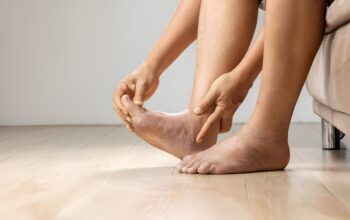If you’ve been experiencing pain in the top of your foot, you may be wondering what could be causing it. Foot pain can be a frustrating and debilitating problem, but understanding its causes is crucial for finding effective treatment and relief. In this article, we will explore common causes of foot pain, the associated symptoms, and available treatment options.
Key Takeaways:
- Foot pain in the top of the foot can be caused by overexertion, injury, or underlying medical conditions.
- Common causes include sprains, fractures, tendonitis, arthritis, and gout.
- Symptoms may include pain, swelling, bruising, and difficulty walking.
- Diagnosis involves a physical examination and may require imaging tests.
- Treatment options vary depending on the underlying cause, ranging from rest and elevation to medication or surgery.
Common Causes of Top Foot Pain
The top of the foot can experience pain due to different causes. Here are some common foot pain causes that may contribute to discomfort in this area:
- Overuse injuries: Activities that involve repetitive stress on the foot, such as running or jumping, can strain the tendons and muscles, leading to pain in the top of the foot.
- Gout: This condition is characterized by a buildup of uric acid crystals in the joints. Gout can cause sudden and intense pain, particularly in the joint at the base of the big toe.
- Sprains: An injury to the ligaments of the foot can cause top foot pain. This can occur from improper foot placement or from sudden movements.
- Fracture: A break in the bones of the foot can result in significant pain and swelling in the top of the foot. Fractures can occur due to trauma or stress on the foot.
- Tendonitis: Inflammation of the tendons in the foot can lead to pain and discomfort. Tendonitis can occur from overuse or repetitive motion.
- Arthritis: Certain types of arthritis, such as rheumatoid arthritis or osteoarthritis, can affect the joints in the foot, causing pain and inflammation.
Identifying the specific cause of your foot pain is essential for guiding appropriate treatment. It is recommended to consult with a healthcare professional for an accurate diagnosis and personalized treatment plan.
Comparison of Common Causes of Top Foot Pain
| Cause | Description | Treatment |
|---|---|---|
| Overuse injuries | Pain due to repetitive stress on the foot | Rest, icing, stretching, supportive footwear |
| Gout | Sudden and intense pain from uric acid crystal buildup | Medication, lifestyle modifications, avoidance of trigger foods |
| Sprains | Ligament injury causing pain and swelling in the top of the foot | Rest, immobilization, physical therapy |
| Fracture | Bone break leading to significant pain and swelling | Immobilization, possible surgical intervention |
| Tendonitis | Inflammation of the tendons in the foot | Rest, physical therapy, anti-inflammatory medication |
| Arthritis | Joint inflammation and damage in the foot | Medication, physical therapy, lifestyle changes |
Understanding the specific cause of your foot pain is crucial for effective treatment and relief. Consult with a healthcare professional to determine the appropriate management plan for your condition.
Symptoms and Diagnosis of Top Foot Pain
Symptoms of top foot pain may vary depending on the underlying cause. They can include pain, swelling, bruising, stiffness, and difficulty walking or standing. When experiencing pain in the top of your foot, it is important to pay attention to these symptoms and seek appropriate medical attention.
To diagnose the cause of your foot pain, a healthcare professional will likely perform a physical examination to assess the affected area. They may also ask about your symptoms and medical history to gather more information. In some cases, imaging tests like X-rays or an MRI may be ordered to get a clearer view of the foot structures and identify any abnormalities.
Treatment Options for Top Foot Pain
The treatment for top foot pain depends on the underlying cause. By addressing the root cause, you can find relief and improve your overall foot health. Here are some treatment options to consider:
- Rest and Elevation: One of the first steps in treating foot pain is to rest the affected foot and elevate it to reduce swelling and inflammation.
- Ice Packs: Applying ice packs to the painful area can help alleviate pain and reduce swelling. Remember to wrap the ice pack in a cloth to protect your skin.
- Supportive Shoes: Wearing shoes that provide proper support and have soft insoles can help reduce pressure on the foot and alleviate pain. Consider using orthotic inserts for added support.
- Over-the-Counter Painkillers: Non-prescription pain relievers like acetaminophen or ibuprofen may help manage mild to moderate foot pain.
- Anti-Inflammatory Gels: Topical gels or creams containing anti-inflammatory ingredients can be applied directly to the affected area for targeted pain relief.
- Physical Therapy: In cases of more severe or chronic foot pain, a physical therapist can design a customized exercise and stretching program to strengthen the foot and improve flexibility.
- Medication: In some situations, your healthcare professional may prescribe stronger pain medications or anti-inflammatory drugs to manage the pain and reduce inflammation.
- Surgery: If conservative treatments fail to provide relief, surgery may be recommended in certain cases. This option is usually considered for severe foot conditions or when other treatments have been ineffective.
Remember, proper diagnosis is crucial for determining the appropriate treatment approach. Consult with a healthcare professional to discuss your symptoms, receive an accurate diagnosis, and develop a personalized treatment plan to address your top foot pain.

Managing and Preventing Top Foot Pain
After addressing the initial pain, managing and preventing future foot pain is important. There are several strategies you can incorporate into your routine to help alleviate and minimize top foot pain.
Foot Pain Exercises and Stretches
Engaging in specific foot pain exercises and stretches can strengthen the muscles and tendons in your foot and ankle, improving mobility and reducing pain. Here are a few exercises you can try:
- Toes Spread and Squeeze: Start by spreading your toes apart as much as possible, then squeeze them together. Repeat this exercise 10-15 times.
- Calf Raises: Stand straight and slowly rise up on your tiptoes, then lower yourself back down. Perform 10-15 repetitions.
- Foot Arch Stretch: Sit on a chair and place a tennis ball or a similar object under the arch of your foot. Roll the ball back and forth for a few minutes, applying gentle pressure.
Supportive Footwear and Orthotic Inserts
Choosing the right footwear is crucial for managing and preventing top foot pain. Look for shoes that provide adequate arch support, cushioning, and stability. Consider using orthotic inserts or insoles tailored to your specific foot shape and needs. These can help distribute pressure more evenly and promote proper alignment, reducing strain on your foot.
Avoiding Activities that Exacerbate Pain
If you’ve identified certain activities or habits that worsen your foot pain, it’s important to avoid or modify them. This may include high-impact exercises, prolonged standing or walking on hard surfaces, or wearing unsupportive shoes. Listen to your body and make adjustments to your routine to reduce stress on your feet.
Maintaining a Healthy Weight
Excess body weight can put additional strain on your feet and exacerbate top foot pain. By maintaining a healthy weight through a balanced diet and regular exercise, you can relieve pressure on your feet and reduce discomfort.
Regular Foot Care
Taking care of your feet is essential for overall foot health. Practice proper hygiene by washing your feet daily and thoroughly drying them, especially between the toes. Trim your toenails straight across to avoid ingrown nails. Regularly check your feet for any abnormalities, such as cuts, sores, or swelling, as early detection can prevent more serious issues.
In addition, scheduling regular check-ups with a healthcare professional can help identify any potential foot problems and provide early intervention.
By incorporating these strategies into your routine, you can effectively manage and prevent top foot pain, improving your overall foot health and quality of life.
When to Seek Medical Attention for Top Foot Pain
While many cases of top foot pain can be managed at home, there are certain situations where medical attention should be sought. These include:
- Severe pain that does not improve after home treatment: If you have tried rest, ice, and over-the-counter pain relievers, but the pain persists or worsens, it is important to consult with a healthcare professional for a proper diagnosis and treatment plan.
- The presence of tingling or loss of sensation: If along with the foot pain, you experience tingling, numbness, or a loss of sensation in the affected area, it could indicate a nerve-related issue that requires medical evaluation.
- Foot deformities: If you notice any visible changes in the structure or alignment of your foot, such as swelling, deformities, or misalignment, it is crucial to have it examined by a healthcare professional to determine the underlying cause and appropriate management.
- Pain interfering with daily activities: If the foot pain significantly hinders your ability to walk, stand, or engage in your regular activities, seeking medical attention is recommended to address the root cause and optimize pain management strategies.
By promptly seeking medical attention in these situations, you can ensure an accurate diagnosis and receive appropriate treatment to alleviate your foot pain symptoms.
Common Situations Requiring Medical Attention for Foot Pain
| Situation | Recommendation |
|---|---|
| Severe pain that does not improve after home treatment | Consult a healthcare professional for diagnosis and treatment |
| The presence of tingling or loss of sensation | Seek medical evaluation to assess nerve-related issues |
| Foot deformities | Have it examined by a healthcare professional to determine the underlying cause |
| Pain interfering with daily activities | Consult a healthcare professional for evaluation and pain management strategies |
Conclusion
Foot pain can greatly affect your daily activities and quality of life. To find relief, it is crucial to understand the causes of foot pain and seek appropriate treatment. Whether your foot pain is a result of overuse, injury, or an underlying medical condition, there are various treatment options available.
By actively managing and preventing foot pain, you can improve your overall foot health. This includes implementing exercises and stretches to strengthen your foot and ankle, using supportive footwear with orthotic inserts, and avoiding activities that worsen the pain. Taking care of your feet through regular hygiene and check-ups also contributes to long-term foot health.
If you are experiencing persistent or severe top foot pain, it is advisable to consult with a healthcare professional. They can provide you with an accurate diagnosis and create a personalized treatment plan to address your specific needs. Remember, proper diagnosis is essential for effective foot pain relief and improved well-being.
FAQ
Why does the top of my foot hurt?
There can be various causes for pain in the top of the foot, including overexertion, injury, tendonitis, arthritis, and gout.
What are the common causes of top foot pain?
Common causes of top foot pain include sprains, fractures, tendonitis, arthritis, and gout.
What are the symptoms and how is top foot pain diagnosed?
Symptoms of top foot pain can include pain, swelling, bruising, stiffness, and difficulty walking. A healthcare professional will perform a physical examination and may order imaging tests like X-rays or an MRI to diagnose the cause of the pain.
What are the treatment options for top foot pain?
Treatment options for top foot pain can include rest, elevation, ice packs, supportive shoes, painkillers, anti-inflammatory gels, physical therapy, medication, and surgery depending on the underlying cause.
How can I manage and prevent top foot pain?
Managing and preventing top foot pain may involve exercises and stretches to strengthen the foot, using supportive footwear and orthotic inserts, avoiding aggravating activities, maintaining a healthy weight, and practicing proper foot care.
When should I seek medical attention for top foot pain?
Medical attention should be sought if the pain does not improve after home treatment, there is tingling or loss of sensation, foot deformities are present, or if the pain is interfering with daily activities.







